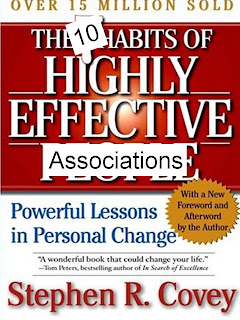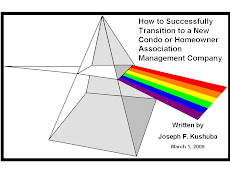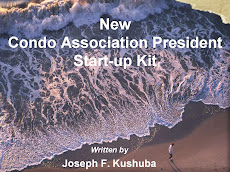 Taking a page out of Steven R. Covey’s bestseller book, “7 Habits of Highly Effective People”, a similar framework can be constructed for condo or homeowner associations. This is a collection of best practices that can play an important role in the effectiveness of an association. The implementation of these best practices involves knowledge, skill, and desire. Knowledge allows us to know what to do, skill gives the ability to know how to do it, and desire is the motivation to do it. These practices have a strong track record of success and will provide any BoD a high return on their investment.
Taking a page out of Steven R. Covey’s bestseller book, “7 Habits of Highly Effective People”, a similar framework can be constructed for condo or homeowner associations. This is a collection of best practices that can play an important role in the effectiveness of an association. The implementation of these best practices involves knowledge, skill, and desire. Knowledge allows us to know what to do, skill gives the ability to know how to do it, and desire is the motivation to do it. These practices have a strong track record of success and will provide any BoD a high return on their investment.Communication
Probably the most important element in the success of any condo association is effective communications. A successful communications system can forestall the development of cliques and factions, enable the association to provide services that owners want, and can help owners develop a sense of trust with the BoD. You should carefully craft a staged communications plan that identifies what information will be communicated (new information, progress to date, anticipated problems, decisions made), how it will be communicated (personal contact, letter or email, group meeting), by whom will it be communicated (President, Secretary, all BoD), and when will it be communicated (date, frequency). You want to give the association members a steady flow of information that addresses the things on their mind along with the things that the BoD wants to communicate to them. Other communication options include:
- Go electronic. It is time for associations to go electronic. If your governing documents do not allow it, change them. There are simply too many benefits to be gained. All the association’s records should be stored in electronic form to save space and money drain.
- Use e-mail for correspondence and go paperless whenever it is beneficial. Depending on what your covenants/bylaws and state/local government rules state, you may also use e-mail to distribute the annual budget or notify owners of covenant violations and overdue assessments.
- Websites can be developed and maintained at minimal cost to condo associations. An effective website can contain viewable and downloadable copies of all of the association’s material records, such as its governing documents, meeting minutes, financial statements, permits, insurance policy, committee structure, business processes, and annual budget. It can also contain forms, copies of the association’s newsletter, a homeowner directory, an event calendar, a community bulletin board. All of these features significantly reduce the need for paper, as well as increase an owner’s ability to become involved in the community. An association website is probably the best move your association can make to improve efficiency and reduce its administration costs.
Management infrastructure
The BoD must understand how decisions will be made, who is to lead and who is to follow, the procedures to be used, the authority levels of its members, the communication system, and a host of other things that should be considered in the performance of their work. If you do not use a management company, you will have to set up your own management control infrastructure. There are multitudes of opinions on the best way to manage a business and there is no loss for management consultants or books that have been written on this subject. At the risk of adding to the fray, it is recommended that a BoD focus its energy on the following elements of a management control system:
- Setting up a committee structure. An effective committee structure helps make an association strong. Committees can lighten the load by focusing on specific tasks that are assigned by the Board. A charter should be developed for each, as well-formulated marching orders can greatly improve the effectiveness of new committees. A charter describes the purpose and authority of the committee, clarifies responsibilities, assures accountability, and creates and limits authority.
- Establishment of several key business processes. Every organization, including associations, should have a set of key business processes in order for it to function in an effective and efficient manner. These processes help define the basic management system and should be well documented, communicated, and understood by all members for them to work properly. The following are recommended; Annual Budget Preparation , Architectural Variance Approval , Assessment and Fee Collection , BoD Request for Decision , Deed Restriction & By-Laws Enforcement , Emergency Contact , Maintenance and Repair Request . If a Management Company is used, they will typically have these in place.
Decision packages
A proven way to help a BoD make decisions is with the use of decision packages that describes everything one should know about an issue, along with a recommended course of action in a very condensed format. The advance work will help you to quickly come up to speed on pertinent information, alternatives that were considered, and an analysis of the preferred solution. It will help you make effective decisions in a timely fashion and save hours of wasted meeting time trying to get the decision makers to a common level of understanding.
Clear roles and responsibilities
There are two important ingredients for a successful Board: One is getting the best people to serve as members and the other is making sure that they know what they are supposed to do. Too many Boards fall into the categories of; “rubber stamps" that dutifully follow the lead of the association’s president; micro managers" who get too caught up in the day-to-day operations of the organization and can't delegate to those responsible for making things happen; or “ineffective” who can’t make decisions, particularly tough decisions that may be unpopular with some members. One of the largest sources of conflict in a BoD occurs when the roles and responsibilities are not clear. Most by-law provisions describe officer’s duties in very broad terms, leaving lots of opportunity for role confusion, overlaps, and/or omissions. As with any effective team, BoD members can’t perform effectively if role questions or overlaps are present. Don’t leave people to figure out things on their own. Get rid of role ambiguity. Nail down every person’s responsibilities with clarity, precision, and attention to detail. There should be no question regarding where one job stops and the next one starts. A detailed BoD roles & responsibility document that supplements the governing documents should be developed and agreed upon by BoD members.
Financial health
Healthy finances are absolutely critical to the sound operation of an association. If you finances are good, it takes the pressure off and will tend to overshadow the minor issues. There are many factors that come into play, including; accounting controls to protect the association’s assets, well thought out and implemented budgets to ensure there is enough operating capital to over the ordinary expenses of the association, and detailed reserve studies to provide enough capital for future capital expenditures. One of the most important things a BoD can do is to create the right cost-conscious mindset with all association members and particularly with the BoD and the Management Company, if one is used. BoD members should continually look for ways to reduce costs and to challenge every budget line item. Any cost increases should receive the highest level of scrutiny. Ask others to justify expenditures. Always, be on the lookout for ways to cut costs, even if they are small amounts.
Rapid decision making
Making timely decisions is a major responsibility of an association BoD. If decisions are not made in a timely manner, it can lead to owner frustration, additional costs, rework, increased wait time, and a host of other undesirable things. Effective BoD’s place particular emphasis on making rapid decisions. They institute processes to facilitate quick decision making, provide pertinent and factual information regarding the issue, provide for the exploration of appropriate decision alternatives, and finally to document all of this information for future reference.
Ethical behavior
Board members are elected to make decisions in the best interest of the association they serve. They are charged with a duty of loyalty and fiduciary responsibility to use good business judgment in conducting the governance of the association. Directors must make sure that their decisions work to the benefit and protection of property values in general and without consideration of personal interest or gain. Members of the Board are protected by the business judgment rule, so long as the Board acts for the purposes of the association, within the scope of its authority and in good faith. It is not illegal to err or even cause financial loss or other harm provided that the Board can demonstrate reasonable investigation, consideration, thoroughness, and good business judgment in reaching its decisions. But, truly ethical practices require more than a fear of legal consequences or a desire for a good reputation. They require a clear understanding of right and wrong, and a motivation on the part of directors, members and contractors to act in the proper manner at all times. This means adhering to not only the letter but also the spirit of all applicable laws and regulations. A written code of ethics policy helps to maintain a culture of honesty and accountability.
Effective Meetings
Efficient and effective meetings are a hallmark of a well run association BoD. A poorly run meeting is expensive and can burn up an inordinate amount of time. Effective BoD’s first know when and when not to hold a meeting. They avoid a meeting if the same information could be covered in a memo, e-mail or brief report. They set meeting objectives before planning the agenda for the meeting. They provide all participants with an agenda before the meeting starts. They give all participants something to prepare for the meeting to assure that meeting has significance to each group member. They practice good meeting mechanics like; sticking to the agenda, starting and ending on time, making assignments for items requiring action, and taking minutes. Also, savvy Board members NEVER have the board meeting "at" the board meeting. They ALWAYS contact other BoD members in advance of the meeting to get their input and reactions to important issues that will be discussed. This can be a time to build support for a particular course of action, to identify any “blind spots” or holes that you may have missed, and to gather information that may be critical for a successful implementation.
BoD leadership, management, and involvement
The Board's main focus must be to ensure the organization is aimed at providing the very most benefit possible for the association members that it serves. It must focus on the on-going capacity to provide that benefit and to assure that the proper management and control system is in place and that it is functioning correctly. For a Board to succeed, the number one key ingredient is: Involvement. Boards fail (and, in turn, associations fail) when board members become disengaged from either the mission of the association or their role in the governance of the organization. An engaged Board does more than simply show up for scheduled meetings and vote to approve minutes and budgets. Engaged boards partake in vigorous discussions that help shape the vision and future direction of their association. Engaged Boards ask questions of their Management Company and becomes educated on the issues their association is involved in. Engaged Boards read and understand monthly financial statements and accept their responsibility for ensuring the association’s short-term stability and long-term sustainability. Engaged boards define expectations for their Management Company and confront any poor performance. And, finally, engaged Boards must learn when it is appropriate to micromanage and when it is not.








No comments:
Post a Comment